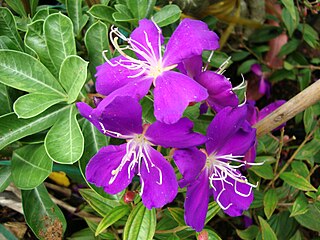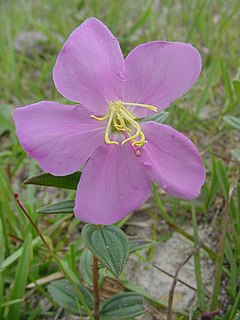
Tibouchina is a neotropical flowering plant genus in the family Melastomataceae. Species of this genus are subshrubs, shrubs or small trees and typically have purple flowers. They are native to Mexico, the Caribbean, and South America where they are found as far south as northern Argentina. Members of this genus are known as glory bushes, glory trees or princess flowers. The name Tibouchina is adapted from a Guianan indigenous name for a member of this genus. A systematic study in 2013 showed that as then circumscribed the genus was paraphyletic, and in 2019 the genus was split into a more narrowly circumscribed Tibouchina, two re-established genera Pleroma and Chaetogastra, and a new genus, Andesanthus.

Pleroma semidecandrum, synonym Tibouchina semidecandra, the princess flower, glory bush, or lasiandra, is a flowering plant in the family Melastomataceae, native to southeast Brazil.

Pleroma urvilleanum, synonym Tibouchina urvilleana, is a species of flowering plant in the family Melastomataceae, native to Brazil.

Andesanthus lepidotus, synonym Tibouchina lepidota, also known as alstonville, Andean princess flower, lasiandra, or glory bush, is a medium-sized ornamental tree or a large shrub native to northwestern South America that is cultivated for its masses of purple flowers from autumn right through to winter.

Chaetogastra is a genus of flowering plants belonging to the family Melastomataceae. Its native range is South America and North America. It contains around 115 species.
Tibouchina aegopogon is a species of flowering plant in the family Melastomataceae, native to Bolivia and Brazil.
Tibouchina albescens is a species of flowering plant in the family Melastomataceae, native to Bolivia and Brazil. It was first formally described in 2015.
Tibouchina edmundoi is a species of flowering plant in the family Melastomataceae, native to north Brazil. It was first described by Alexander Curt Brade in 1959.
Tibouchina llanorum is a species of flowering plant in the family Melastomataceae, native to Bolivia, north Brazil, Colombia and Venezuela. It was first described by John Julius Wurdack in 1964.
Tibouchina verticillaris is a species of flowering plant in the family Melastomataceae, native to Brazil. It was first described by Alfred Cogniaux in 1885.
Tibouchina araguaiensis is a species of flowering plant in the family Melastomataceae, native to north Brazil. It was first described by Paulo J.F. Guimarães in 2014.

Tibouchina aspera is a species of flowering plant in the family Melastomataceae, native to Central America and tropical South America. It was first described by Jean Fusée Aublet in 1775. In the original description of the species, it was suggested that the plant was inhaled to treat chest pain and dry coughs.

Andesanthus is a genus of flowering plant in the family Melastomataceae, native to Colombia, Costa Rica, Ecuador, Panama, Peru and Venezuela. The genus was established in 2019 for some species formerly placed in Tibouchina. Some species are cultivated as ornamental shrubs or trees.
Tibouchina bipenicillata is a species of flowering plant in the family Melastomataceae, native to Colombia, Costa Rica, Panama and Venezuela. The type specimen is kept in the herbarium at Conservatoire et Jardin botaniques de la Ville de Genève in Switzerland.
Tibouchina johnwurdackiana is a species of flowering plant in the family Melastomataceae, native to west central Brazil. It was first described in 1997. The type specimen is kept in the herbarium at Missouri Botanical Garden.
Tibouchina melastomoides is a species of flowering plant in the family Melastomataceae, native to Brazil. It was first described in 1850, as Lasiandra melastomoides, by Charles Victor Naudin. The type specimen is kept in Naturhistorisches Museum Wien in Austria.
Tibouchina striphnocalyx is a species of flowering plant in the family Melastomataceae, native to north Brazil, Colombia and Venezuela. It was first described in 1828 by Augustin de Candolle as Osbeckia striphnocalyx.
Tibouchina bruniana is a species of flowering plant in the family Melastomataceae, native to Brazil. It was first described in 2014. Distinguishing characteristics of Tibouchina bruniana are the solitary flowers and the small leaves. The anthers have long, simple trichomes which led to this species being placed in the section Barbigerae. This shrub is found in cerrado vegetation, growing in compacted soil and in swampy areas at around 1,100 metres. The species is only known from one population growing close to a nickel mine in the Brazilian state of Goiás.
Tibouchina nigricans is a species of flowering plant in the family Melastomataceae, native to west-central Brazil. It was first described in 2015 with the name attributed to the earlier botanist Alfred Cogniaux. The type specimens are kept at the Missouri Botanical Gardens and at Botanischer Garten und Botanisches Museum Berlin-Dahlem, Berlin.

Pleroma asperius is a species of flowering plant in the family Melastomataceae, native to Brazil. It was first described by Adelbert von Chamisso in 1834 as Lasiandra asperior. One of its synonyms is Tibouchina asperior.








